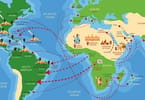The travel industry isn’t dead; just wounded. As the dust cloud that has engulfed it this year starts to dissipate, travel companies, from airlines to hotel operators, are pondering what comes next. In an era of reduced air travel, diminished business trips, and where “staycations” may trump vacations for the foreseeable, how can companies remain profitable?
The answer, counterintuitive as it may sound, is to collaborate with businesses that were once their closest competitors. If the travel industry is to be reborn, phoenix-like, from the flames of 2020, it will be under a banner of mutual cooperation. No more protectionism, keeping customers locked into single ecosystems. And the starting point for this reimagining of the travel industry is loyalty points. If you want to create loyal customers, it turns out, the greatest thing your business can do is free them to spend your loyalty points anywhere.
Loyalty Points Are Worth a Lotta Lolly
Loyalty programs are a $200 billion industry, with the travel sector accounting for a hefty slice of that. Despite their economic might, the bulk of all loyalty points that are doled out go to waste. As a result, travelers miss out on the rewards they are entitled to, and businesses miss out on the chance to turn consumers into life-long customers. For the travel industry, this inefficiency is particularly pronounced, as travelers are prone to racking up points that are unspendable beyond the region they’re visiting – which they may not have the opportunity to return to for years, if ever.
This problem will become more pronounced as the repercussions of the Covid-19 lockdown compel travelers to be more selective about the distances they travel and the frequency they fly. Wasted loyalty points don’t just disadvantage the customer: they’re also a wasted opportunity for travel operators to increase the number of returning customers and average spend per customer.
The solution – to unlock loyalty points and make them spendable anywhere – is simple. Finding a technical framework to connect these siloed systems, and the cross-industry consensus to achieve it, however, is anything but. But after many setbacks and false dawns, there are signs that the travel industry is starting to make headway here at last. Thanks to the efforts of companies such as MiL.k Alliance, loyalty points are finally being freed from their chains and repurposed as the global incentivization and rewards system they were always meant to be.
The Future of Loyalty Points Lies in Interoperability
MiL.k partners with companies in the travel, lifestyle and leisure sectors and aims to streamline mileage programs to give loyalty points greater utility. Instead of loyalty points from airlines, hotels and duty-free shops going to waste, MiL.k lets customers receive them on its platform and spend them more freely with different vendors.
MiL.k isn’t the only project taking on the travel industry’s incompatible loyalty points problem, but it’s the one that’s made the most headway. In recent months, an integration with Yanolja, South Korea’s fastest growing online travel agency, has made Yanolja points compatible with MiL.k promotions, increasing their utility and spendability. A similar initiative has made loyalty points convertible into coupons that can be redeemed in stores for movie tickets, hot and cold drinks, and fast food. MiL.k’s platform provides an example of how blockchain can add value by providing a single network to aggregate loyalty points awarded by various service providers.
Collaboration Shouldn’t Come at the Expense of Competition
Travel companies collaborating by making their loyalty points spendable with their competitors and vice-versa doesn’t mark an end to competition. In fact, quite the opposite. In an interconnected economy anchored by a universal loyalty point collection and redemption platform, businesses compete on quality of service and customers are free to frequent the firms that offer the most bang for their buck: the most points, upgrades, add-ons, value, and best customer service.
We’re not there yet. The travel industry is still bruised from the battering it’s taken by this year’s unprecedented events, and it will be months or years until the sector returns to full strength. Some travel operators and chains will fold, while others will be forced to downsize or be absorbed into larger companies. While the natural cycle of business plays out, travel companies must start looking at the bigger picture, and acknowledge that their fortunes lie in unlocking value through collaboration with other industry players. Because the journey to financial recovery starts and ends with better customer care.
#rebuildingtravel
WHAT TO TAKE AWAY FROM THIS ARTICLE:
- In an interconnected economy anchored by a universal loyalty point collection and redemption platform, businesses compete on quality of service and customers are free to frequent the firms that offer the most bang for their buck.
- For the travel industry, this inefficiency is particularly pronounced, as travelers are prone to racking up points that are unspendable beyond the region they're visiting – which they may not have the opportunity to return to for years, if ever.
- The travel industry is still bruised from the battering it's taken by this year's unprecedented events, and it will be months or years until the sector returns to full strength.

















![China's Hyperloop Train: A Glimpse into the Future of Transportation 17 Travel Tourism News | Domestic & International Hyperloop Train China [Photo: Hyperloop Transportation Technologies]](/cdn-cgi/image/width=145,height=100,fit=crop,quality=80,format=auto,onerror=redirect,metadata=none/wp-content/uploads/2024/02/180720163348-hyperlooptt-china-capsule.jpg)



